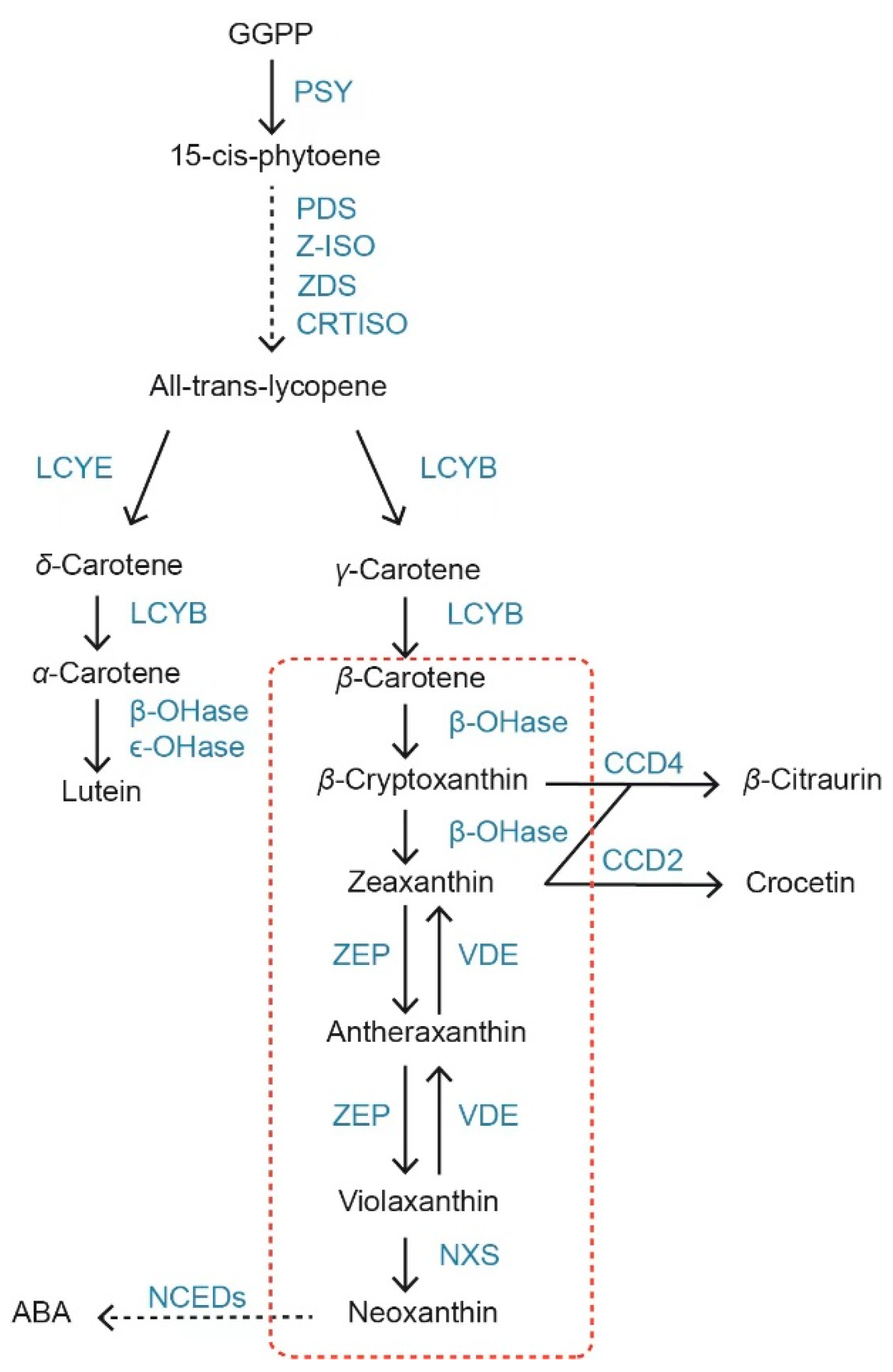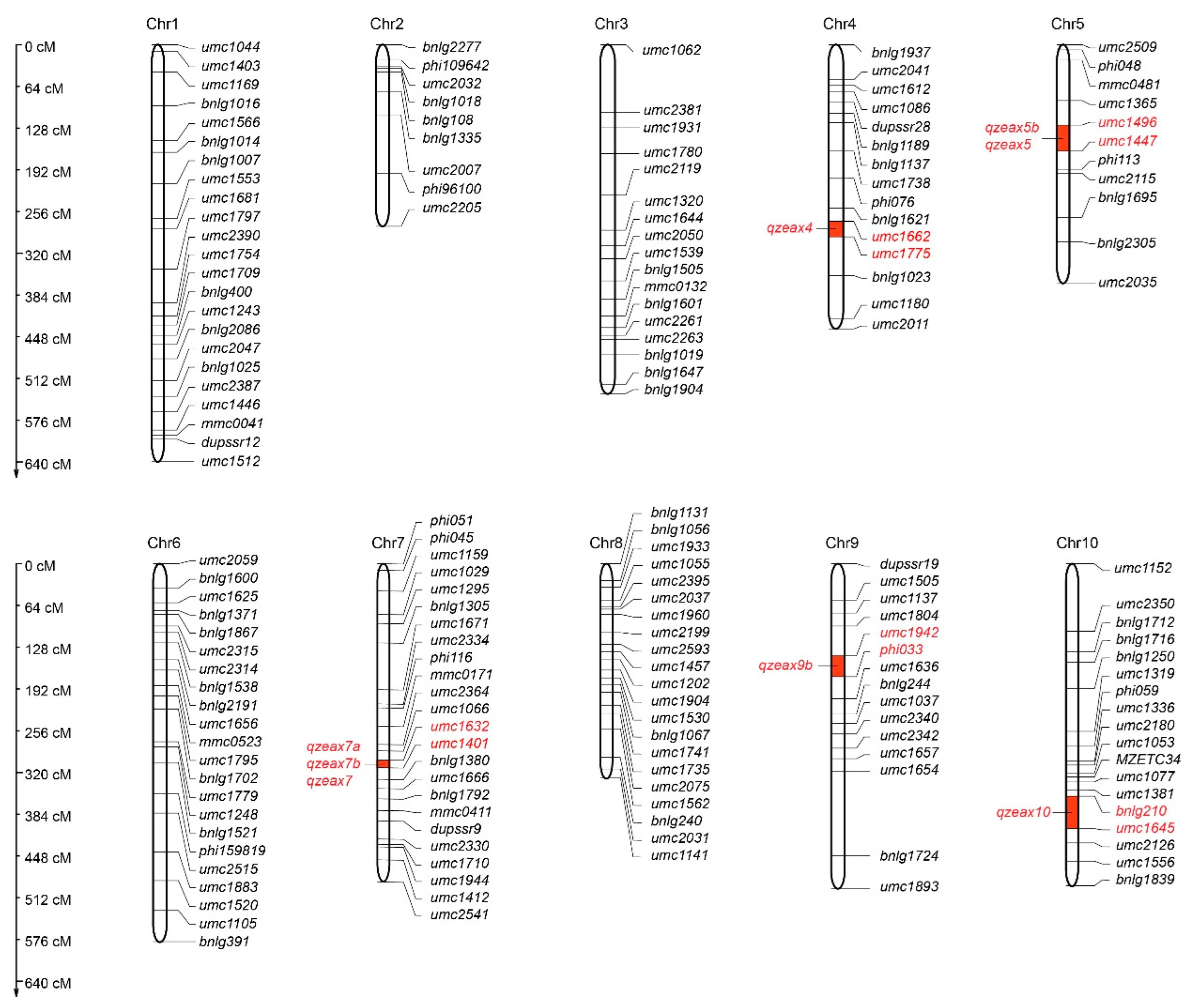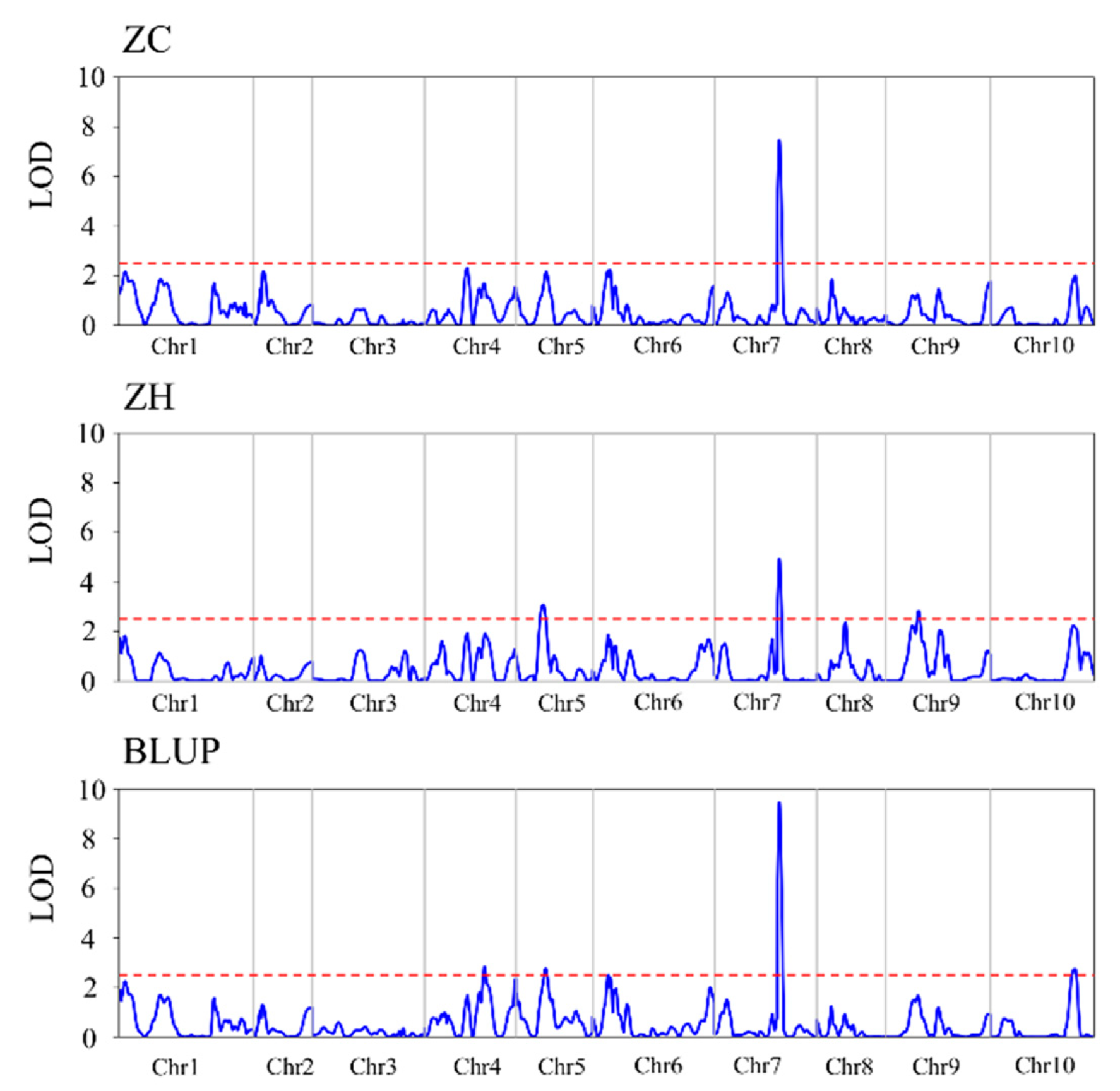QTL Mapping of Zeaxanthin Content in Sweet Corn Using Recombinant Inbred Line Population across Different Environments
Abstract
1. Introduction
2. Results
2.1. Construction of the Zeaxanthin Calibration Curve
2.2. Analysis of Zeaxanthin Content in the RIL Population
2.3. Construction of the Genetic Map of the RIL Population
2.4. QTL Mapping of Zeaxanthin in the RIL Population
3. Discussion
4. Materials and Methods
4.1. Plant Material, Population Construction, and DNA Extraction
4.2. Extraction and Determination of Zeaxanthin
4.3. Construction of the Zeaxanthin Standard Curve
4.4. Genotyping and Analysis
4.5. Data Processing and Statistical Analysis
Author Contributions
Funding
Data Availability Statement
Acknowledgments
Conflicts of Interest
References
- Khachik, F. Distribution and metabolism of dietary carotenoids in humans as a criterion for development of nutritional supplements. Pure Appl. Chem. 2006, 78, 1551–1557. [Google Scholar] [CrossRef]
- Sabour-Pickett, S.; Nolan, J.M.; Loughman, J.; Beatty, S. A review of the evidence germane to the putative protective role of the macular carotenoids for age-related macular degeneration. Mol. Nutr. Food Res. 2012, 56, 270–286. [Google Scholar] [CrossRef]
- Congdon, N.; O’Colmain, B.; Klaver, C.; Klein, R.; Munoz, B.; Friedman, D.S.; Kempen, J.; Taylor, H.R.; Mitchell, P.; Hyman, L. Causes and prevalence of visual impairment among adults in the United States. Arch. Ophthalmol. 2004, 122, 477–485. [Google Scholar] [PubMed]
- Flaxman, S.R.; Bourne, R.R.A.; Resnikoff, S.; Ackland, P.; Braithwaite, T.; Cicinelli, M.V.; Das, A.; Jonas, J.B.; Keeffe, J.; Kempen, J.H.; et al. Global causes of blindness and distance vision impairment 1990–2020: A systematic review and meta-analysis. Lancet Glob. Health 2017, 5, E1221–E1234. [Google Scholar] [CrossRef]
- Bone, R.A.; Landrum, J.T.; Hime, G.W.; Cains, A.; Zamor, J. Stereochemistry of the human macular carotenoids. Investig. Ophth. Vis. Sci. 1993, 34, 2033–2040. [Google Scholar]
- Chew, E.Y.; Clemons, T.E.; Sangiovanni, J.P.; Danis, R.P.; Ferris, F.R.; Elman, M.J.; Antoszyk, A.N.; Ruby, A.J.; Orth, D.; Bressler, S.B.; et al. Secondary analyses of the effects of lutein/zeaxanthin on age-related macular degeneration progression: AREDS2 report No. 3. JAMA Ophthalmol. 2014, 132, 142–149. [Google Scholar] [CrossRef]
- Arunkumar, R.; Calvo, C.M.; Conrady, C.D.; Bernstein, P.S. What do we know about the macular pigment in AMD: The past, the present, and the future. Eye 2018, 32, 992–1004. [Google Scholar] [CrossRef]
- Gorusupudi, A.; Nelson, K.; Bernstein, P.S. The Age-Related Eye Disease 2 Study: Micronutrients in the Treatment of Macular Degeneration. Adv. Nutr. 2017, 8, 40–53. [Google Scholar] [CrossRef]
- Sauer, L.; Li, B.; Bernstein, P.S. Ocular Carotenoid Status in Health and Disease. Annu. Rev. Nutr. 2019, 39, 95–120. [Google Scholar] [CrossRef]
- Wu, J.; Cho, E.; Willett, W.C.; Sastry, S.M.; Schaumberg, D.A. Intakes of Lutein, Zeaxanthin, and Other Carotenoids and Age-Related Macular Degeneration During 2 Decades of Prospective Follow-up. JAMA Ophthalmol. 2015, 133, 1415–1424. [Google Scholar] [CrossRef]
- Dwyer, J.H.; Navab, M.; Dwyer, K.M.; Hassan, K.; Sun, P.; Shircore, A.; Hama-Levy, S.; Hough, G.; Wang, X.; Drake, T.; et al. Oxygenated carotenoid lutein and progression of early atherosclerosis: The Los Angeles atherosclerosis study. Circulation 2001, 103, 2922–2927. [Google Scholar] [CrossRef] [PubMed]
- Johnson, E.J. Role of lutein and zeaxanthin in visual and cognitive function throughout the lifespan. Nutr. Rev. 2014, 72, 605–612. [Google Scholar] [CrossRef] [PubMed]
- Wang, L.; Li, B.; Pan, M.X.; Mo, X.F.; Chen, Y.M.; Zhang, C.X. Specific carotenoid intake is inversely associated with the risk of breast cancer among Chinese women. Brit. J. Nutr. 2014, 111, 1686–1695. [Google Scholar] [CrossRef] [PubMed]
- Leoncini, E.; Edefonti, V.; Hashibe, M.; Parpinel, M.; Cadoni, G.; Ferraroni, M.; Serraino, D.; Matsuo, K.; Olshan, A.F.; Zevallos, J.P.; et al. Carotenoid intake and head and neck cancer: A pooled analysis in the International Head and Neck Cancer Epidemiology Consortium. Eur. J. Epidemiol. 2016, 31, 369–383. [Google Scholar] [CrossRef]
- Liau, B.; Hong, S.; Chang, L.; Shen, C.; Li, Y.; Wu, Y.; Jong, T.; Shieh, C.; Hsu, S.; Chang, C.J. Separation of sight-protectingzeaxanthin from Nannochloropsisoculata by using super critical fluid sex traction coupled with elution chromatography. Sep. Purif. Technol. 2011, 78, 8. [Google Scholar] [CrossRef]
- Sajilata, M.G.; Singhal, R.S.; Kamat, M.Y. The Carotenoid Pigment Zeaxanthin—A Review. Compr. Rev. Food Sci. 2008, 7, 29–49. [Google Scholar] [CrossRef]
- Fraser, P.D.; Bramley, P.M. The biosynthesis and nutritional uses of carotenoids. Prog. Lipid Res. 2004, 43, 228–265. [Google Scholar] [CrossRef]
- Gallagher, C.E.; Matthews, P.D.; Li, F.; Wurtzel, E.T. Gene duplication in the carotenoid biosynthetic pathway preceded evolution of the grasses. Plant Physiol. 2004, 135, 1776–1783. [Google Scholar] [CrossRef]
- D’Ambrosio, C.; Stigliani, A.L.; Giorio, G. Overexpression of CrtR-b2 (carotene beta hydroxylase 2) from S. lycopersicum L. differentially affects xanthophyll synthesis and accumulation in transgenic tomato plants. Transgenic Res. 2011, 20, 47–60. [Google Scholar] [CrossRef]
- Enfissi, E.M.A.; Nogueira, M.; D’Ambrosio, C.; Stigliani, A.L.; Giorio, G.; Misawa, N.; Fraser, P.D. The road to astaxanthin production in tomato fruit reveals plastid and metabolic adaptation resulting in an unintended high lycopene genotype with delayed over-ripening properties. Plant Biotechnol. J. 2019, 17, 1501–1513. [Google Scholar] [CrossRef]
- Giovanni, G. Plant carotenoids: Genomics meets multi-gene engineering. Curr. Opin. Plant Biol. 2014, 19, 111–117. [Google Scholar]
- Nogueira, M.; Enfissi, E.M.A.; Martínez, V.M.E.; Menard, G.N.; Driller, R.L.; Eastmond, P.J.; Schuch, W.; Sandmann, G.; Fraser, P.D. Engineering of tomato for the sustainable production of ketocarotenoids and its evaluation in aquaculture feed. Proc. Natl. Acad. Sci. USA 2017, 114, 10876–10881. [Google Scholar] [CrossRef]
- Giorio, G.; Stigliani, A.L.; D’Ambrosio, C. Over-expression of carotene b-hydroxylase 1 (CrtR-b1) and lycopene bcyclase (Lcy-b) in transgenic tomato fruits. Acta Hort. 2008, 789, 277–284. [Google Scholar] [CrossRef]
- Gotz, T.; Sandmann, G.; Romer, S. Expression of a bacterial carotenehydroxylase gene (crtZ) enhances UV tolerance into bacco. Plant Mol. Biol. 2002, 50, 14. [Google Scholar] [CrossRef]
- Lee, S.; Jang, S.; Jeong, H.; Lee, S.; Venkatesh, J.; Lee, J.; Kwon, J.; Kang, B. A mutation in Zeaxanthin epoxidase contributes to orange coloration and alters carotenoid contents in pepper fruit (Capsicum annuum). Plant J. 2021, 106, 16. [Google Scholar] [CrossRef] [PubMed]
- Perry, A.; Rasmussen, H.; Johnson, E.J. Xanthophyll (lutein, zeaxanthin) content in fruits, vegetables and corn and egg products. J. Food Compos. Anal. 2009, 22, 9–15. [Google Scholar] [CrossRef]
- Dias, M.G.; Olmedilla-Alonso, B.; Hornero-Méndez, D.; Mercadante, A.Z.; Osorio, C.; Vargas-Murga, L.; Meléndez-Martínez, A.J. Comprehensive Database of Carotenoid Contents in Ibero-American Foods. A Valuable Tool in the Context of Functional Foods and the Establishment of Recommended Intakes of Bioactives. J. Agric. Food Chem. 2018, 66, 5055–5107. [Google Scholar] [CrossRef]
- Yossa, N.I.B.; Guo, B.; Zhang, T.; Wang, L.; Ji, Q.; Xia, H.; Sun, G. Comparative Metabolic Profiling of Lycium Fruits (Lycium barbarum and Lycium chinense) from Different Areas in China and from Nepal. J. Food Qual. 2019, 2019, 4396027. [Google Scholar]
- Burri, B.J.; La Frano, M.R.; Zhu, C. Absorption, metabolism, and functions of beta-cryptoxanthin. Nutr. Rev. 2016, 74, 69–82. [Google Scholar] [CrossRef]
- García, M.I.; Lozano, M.; de Espinosa, V.M.; Ayuso, M.C.; Bernalte, M.J.; Vidal-Aragón, M.C.; Pérez, M.M. Agronomic characteristics and carotenoid content of five Bola-type paprika red pepper (Capsicum annuum L.) cultivars. Sci. Hortic. 2007, 113, 202–207. [Google Scholar] [CrossRef]
- Hornero-Méndez, D.; Costa-García, J.; Mínguez-Mosquera, M.I. Characterization of carotenoid high-producing Capsicum annuum cultivars selected for paprika production. J. Agric. Food Chem. 2002, 50, 5711–5716. [Google Scholar] [CrossRef] [PubMed]
- Maiani, G.; Castón, M.J.P.; Catasta, G.; Toti, E.; Cambrodón, I.G.; Bysted, A.; Granado-Lorencio, F.; Olmedilla-Alonso, B.; Knuthsen, P.; Valoti, M.; et al. Carotenoids: Actual knowledge on food sources, intakes, stability and bioavailability and their protective role in humans. Mol. Nutr. Food Res. 2009, 53 (Suppl. S2), S194–S218. [Google Scholar] [CrossRef] [PubMed]
- Alexandros, P.; Rino, R.; Simone, C.; Stefania, P.; Stefania, C. Carotenoid content of Goji berries: CIELAB, HPLC-DAD analyses and quantitative correlation. Food Chem. 2018, 268, 49–56. [Google Scholar]
- Wong, J.C.; Lambert, R.J.; Wurtzel, E.T.; Rocheford, T.R. QTL and candidate genes phytoene synthase and zeta-carotene desaturase associated with the accumulation of carotenoids in maize. Theor. Appl. Genet. 2004, 108, 349–359. [Google Scholar] [CrossRef]
- Chander, S.; Guo, Y.Q.; Yang, X.H.; Zhang, J.; Lu, X.Q.; Yan, J.B.; Song, T.M.; Rocheford, T.R.; Li, J.S. Using molecular markers to identify two major loci controlling carotenoid contents in maize grain. Theor. Appl. Genet. 2008, 116, 223–233. [Google Scholar] [CrossRef] [PubMed]
- Dong, E.F.; Bai, Y.; Qin, L.P.; Liang, Q.Y.; Liu, C.X.; Cai, Y.L. Identification and epistasis analysis of quantitative trait loci for zeaxanthin concentration in maize kernel across different generations and environments. Breed. Sci. 2020, 70, 212–220. [Google Scholar] [CrossRef]
- O’Hare, T.J.; Fanning, K.J.; Martin, I.F. Zeaxanthin biofortification of sweet-corn and factors affecting zeaxanthin accumulation and colour change. Arch. Biochem. Biophys. 2015, 572, 184–187. [Google Scholar] [CrossRef]
- Romer, S.; Lubeck, J.; Kauder, F.; Steiger, S.; Adomat, C.; Sandmann, G. Genetic Engineering of a Zeaxanthin-rich Potato by Antisense Inactivation and Co-suppression of Carotenoid Epoxidation. Metab. Eng. 2002, 4, 263–272. [Google Scholar] [CrossRef]
- Zhu, C.; Naqvi, S.; Breitenbach, J.; Sandmann, G.; Christou, P.; Capell, T. Combinatorial genetic transformation generates a library of metabolic phenotypes for the carotenoid pathway in maize. Proc. Natl. Acad. Sci. USA 2008, 105, 18232–18237. [Google Scholar] [CrossRef]
- Sridhar, D.; Carlo, R.; Patrizia, P.; Riccardo, A.; Florence, B.; Bilal, C.; Giovanni, G. Metabolic engineering of xanthophyll content in tomato fruits. Febs. Lett. 2002, 519, 30–34. [Google Scholar]
- Karniel, U.; Koch, A.; Zamir, D.; Hirschberg, J. Development of zeaxanthin-rich tomato fruit through genetic manipulations of carotenoid biosynthesis. Plant Biotechnol. J. 2020, 18, 2292–2303. [Google Scholar] [CrossRef] [PubMed]
- Ashrafi, H.; Kinkade, M.; Foolad, M.R. A new genetic linkage map of tomato based on a Solanum lycopersicum × S. pimpinellifolium RIL population displaying locations of candidate pathogen response genes. Genome 2009, 52, 935–956. [Google Scholar] [CrossRef] [PubMed]
- Xiaohong, H.; Chenwu, X.; Jianmin, K.; Shiliang, G.; Tao, L. Principal factors affecting the power of detection and accuracy of QTL mapping. Acta Agron. Sin. 2001, 27, 469–475. [Google Scholar]
- Jittham, O.; Fu, X.Y.; Xu, J.; Chander, S.; Li, J.S.; Yang, X.H. Genetic dissection of carotenoids in maize kernels using high-density single nucleotide polymorphism markers in a recombinant inbred line population. Crop J. 2017, 5, 63–72. [Google Scholar] [CrossRef]
- Manrique-Carpintero, N.C.; Coombs, J.J.; Veilleux, R.E.; Buell, C.R.; Douches, D.S. Comparative Analysis of Regions with Distorted Segregation in Three Diploid Populations of Potato. G3 Genes Genomes Genet. 2016, 6, 2617–2628. [Google Scholar] [CrossRef][Green Version]
- Khedikar, Y.P.; Gowda, M.V.C.; Sarvamangala, C.; Patgar, K.V.; Upadhyaya, H.D.; Varshney, R.K. A QTL study on late leaf spot and rust revealed one major QTL for molecular breeding for rust resistance in groundnut (Arachis hypogaea L.). Theor. Appl. Genet. Theor. Angew. Genet. 2010, 121, 971–984. [Google Scholar] [CrossRef]
- Sarvamangala, C.; Gowda MV, C.; Varshney, R.K. Identification of quantitative trait loci for protein content, oil content and oil quality for groundnut (Arachis hypogaea L.). Field Crop Res. 2011, 122, 49–59. [Google Scholar] [CrossRef]
- Ashokkumar, K.; Govindaraj, M.; Karthikeyan, A.; Shobhana, V.G.; Warkentin, T.D. Genomics-Integrated Breeding for Carotenoids and Folates in Staple Cereal Grains to Reduce Malnutrition. Front. Genet. 2020, 11, 414. [Google Scholar] [CrossRef]
- Singh, M.; Lewis, P.E.; Hardeman, K.; Bai, L.; Rose, J.K.C.; Mazourek, M.; Chomet, P.; Brutnell, T.P. Activator mutagenesis of the pink scutellum1/viviparous7 locus of maize. Plant Cell 2003, 15, 874–884. [Google Scholar] [CrossRef]
- Vallabhaneni, R.; Wurtzel, E.T. Timing and Biosynthetic Potential for Carotenoid Accumulation in Genetically Diverse Germplasm of Maize. Plant Physiol. 2009, 150, 562–572. [Google Scholar] [CrossRef]
- Zhou, Y.; Han, Y.J.; Li, Z.G.; Fu, Y.; Fu, Z.Y.; Xu, S.T.; Li, J.S.; Yan, J.B.; Yang, X.H. ZmcrtRB3 Encodes a Carotenoid Hydroxylase that Affects the Accumulation of alpha-carotene in Maize Kernel. J. Integr. Plant Biol. 2012, 54, 260–269. [Google Scholar] [CrossRef] [PubMed]





| Concentration (μg/mL) | Time (min) | Area (mv * s) |
|---|---|---|
| 0.2 | 11.964 | 22,149 |
| 0.4 | 11.952 | 45,202 |
| 0.8 | 11.961 | 96,548 |
| 2.0 | 11.963 | 257,506 |
| 4.0 | 11.966 | 475,438 |
| Environment | Population | Min | Max | Mean | SD | Skewness | Kurtosis |
|---|---|---|---|---|---|---|---|
| Zengcheng | 166 | 18.66 | 186.14 | 76.32 | 30.43 | 0.69 | 0.52 |
| Zhuhai | 141 | 9.57 | 146.93 | 65.98 | 25.51 | 0.65 | 0.19 |
| BLUP | 182 | 27.49 | 139.02 | 70.88 | 22.53 | 0.56 | −0.07 |
| Variation Source | DF | SS | MS | F | p-Value |
|---|---|---|---|---|---|
| Genotype | 183 | 452,722.25 | 2473.89 | 1455.25 | <0.0001 |
| Environment | 1 | 16,713.75 | 16,713.75 | 9831.73 | <0.0001 |
| Genotype × Environment | 126 | 54,120.81 | 429.53 | 252.67 | <0.0001 |
| Error | 309 | 525.29 | 1.69 | ||
| Total | 619 | 524,082.31 |
| Chromosome | Genetic Distance (cM) | Marker Number (Pairs) | Mean Distance (cM) |
|---|---|---|---|
| Chr1 | 642.90 | 23 | 27.95 |
| Chr2 | 280.42 | 9 | 31.16 |
| Chr3 | 538.21 | 17 | 31.66 |
| Chr4 | 437.68 | 15 | 29.18 |
| Chr5 | 367.73 | 11 | 33.43 |
| Chr6 | 582.61 | 22 | 26.48 |
| Chr7 | 489.34 | 24 | 20.39 |
| Chr8 | 330.96 | 21 | 15.76 |
| Chr9 | 500.41 | 15 | 33.36 |
| Chr10 | 496.97 | 18 | 27.61 |
| Environment | Chromosome | QTL | Marker Interval | LOD | PVE (%) | ADD |
|---|---|---|---|---|---|---|
| ZC | 7 | qZeax7a | umc1632-umc1401 | 7.48 | 20.25 | −14.46 |
| ZH | 5 | qZeax5b | umc1496-umc1447 | 3.08 | 8.80 | 9.27 |
| 7 | qZeax7b | umc1632-umc1401 | 4.92 | 11.28 | −10.48 | |
| 9 | qZeax9b | umc1942-phi033 | 2.84 | 10.13 | −9.93 | |
| BLUP | 4 | qZeax4 | umc1662-umc1775 | 2.83 | 5.91 | 7.10 |
| 5 | qZeax5 | umc1496-umc1447 | 2.76 | 9.21 | 8.82 | |
| 7 | qZeax7 | umc1632-umc1401 | 9.47 | 14.74 | −11.15 | |
| 10 | qZeax10 | bnlg210-umc1645 | 2.74 | 4.43 | 6.08 |
Disclaimer/Publisher’s Note: The statements, opinions and data contained in all publications are solely those of the individual author(s) and contributor(s) and not of MDPI and/or the editor(s). MDPI and/or the editor(s) disclaim responsibility for any injury to people or property resulting from any ideas, methods, instructions or products referred to in the content. |
© 2023 by the authors. Licensee MDPI, Basel, Switzerland. This article is an open access article distributed under the terms and conditions of the Creative Commons Attribution (CC BY) license (https://creativecommons.org/licenses/by/4.0/).
Share and Cite
Zhang, Y.; Tang, Y.; Jin, W.; Liu, Y.; Li, G.; Zhong, W.; Huang, J.; Wang, W. QTL Mapping of Zeaxanthin Content in Sweet Corn Using Recombinant Inbred Line Population across Different Environments. Plants 2023, 12, 3506. https://doi.org/10.3390/plants12193506
Zhang Y, Tang Y, Jin W, Liu Y, Li G, Zhong W, Huang J, Wang W. QTL Mapping of Zeaxanthin Content in Sweet Corn Using Recombinant Inbred Line Population across Different Environments. Plants. 2023; 12(19):3506. https://doi.org/10.3390/plants12193506
Chicago/Turabian StyleZhang, Yahui, Yunqi Tang, Weicai Jin, Yu Liu, Guangyu Li, Wenhao Zhong, Jun Huang, and Wenyi Wang. 2023. "QTL Mapping of Zeaxanthin Content in Sweet Corn Using Recombinant Inbred Line Population across Different Environments" Plants 12, no. 19: 3506. https://doi.org/10.3390/plants12193506
APA StyleZhang, Y., Tang, Y., Jin, W., Liu, Y., Li, G., Zhong, W., Huang, J., & Wang, W. (2023). QTL Mapping of Zeaxanthin Content in Sweet Corn Using Recombinant Inbred Line Population across Different Environments. Plants, 12(19), 3506. https://doi.org/10.3390/plants12193506





